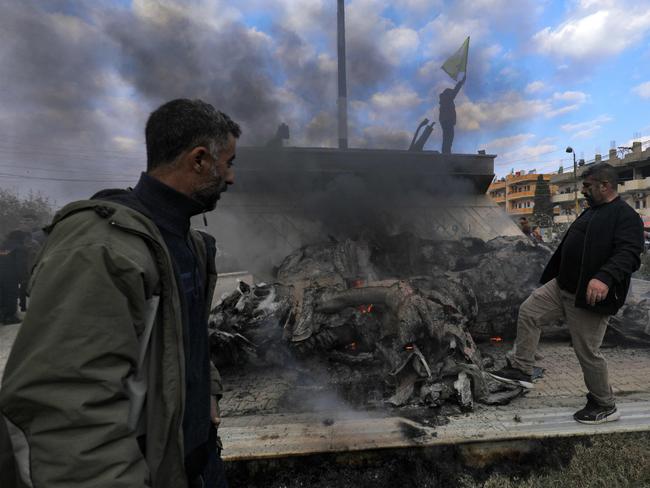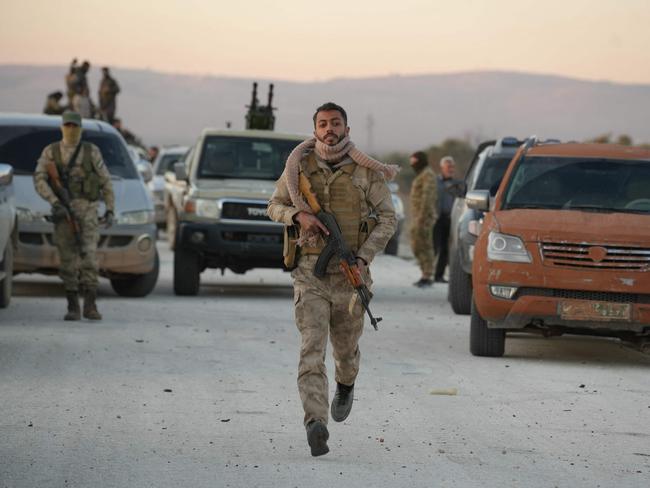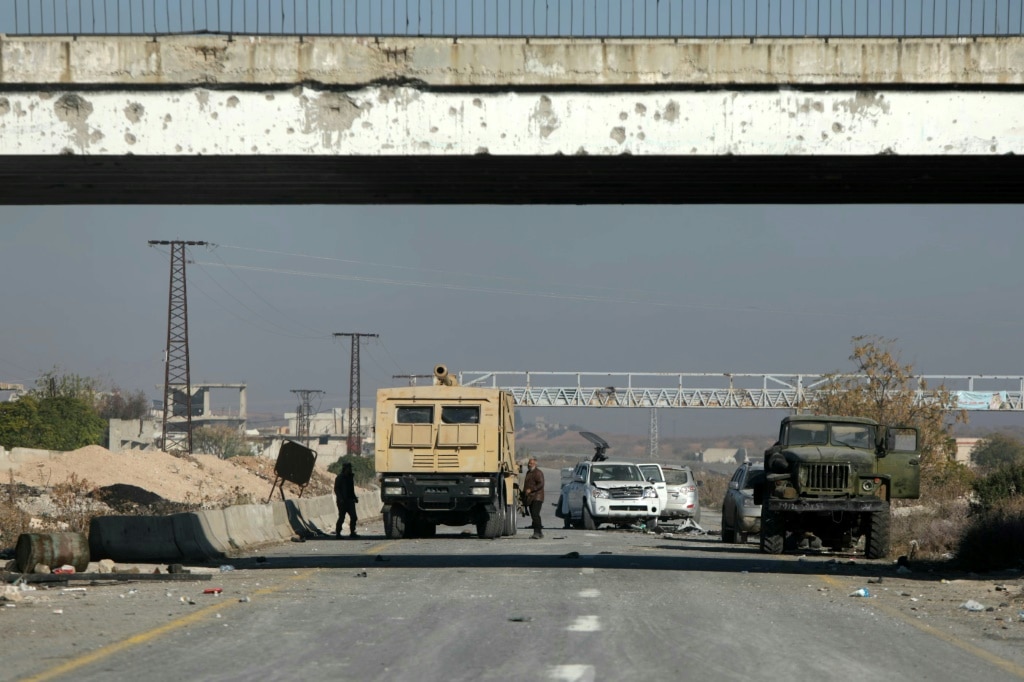Syrian Civil War: What we know about the fall of Syria’s Bashar al-Assad
Syrian rebels swept into Damascus, declaring they had toppled “tyrant” Bashar al-Assad. Here’s what we know about what happened and why.
World
Don't miss out on the headlines from World. Followed categories will be added to My News.
Syrian rebels have swept into Damascus declaring they toppled “tyrant” President Bashar al-Assad, whose current whereabouts are unknown after he reportedly fled the country.
Here’s what we know about where Assad could be, what happened to his regime and who is in charge now after five decades of rule by the Assad dynasty.
How did Assad flee?
The Syrian Observatory for Human Rights war monitor said Assad left on a private plane that took off from Damascus international airport on Saturday night, local time, without specifying where he headed.
After that, the army and security forces pulled out of the airport, with commercial flights already suspended earlier.
The rebels, who began a lightning offensive on October 27, quickly announced they had toppled “tyrant” Assad and that Damascus was a “free” city, calling on millions of Syrians who fled the war for safety abroad to return home.
Assad’s location is not clear, but Observatory chief Rami Abdel Rahman told AFP there were three main possibilities.

The first was that Assad headed to Russia, which over the years has provided key military, political and diplomatic support for the Syrian leader, including with its air power.
Second that he fled to his other main ally Iran, which has sent military advisers to Syria and supported fighters, including from Lebanon’s Hezbollah, who have been on the battlefield alongside government soldiers.
The third option is that Assad went to the United Arab Emirates, the first Arab Gulf country to restore broken ties with Damascus in 2018 after they were severed following the war’s outbreak in 2011.

What led to the fall of Assad?
Aron Lund, a fellow at the Century International think tank, told AFP this week that “the main factor” in the rebels’ success was “regime weakness and reduced international assistance to Assad”.
Islamist rebel leader Abu Mohammed al-Jolani’s “work on building up institutions and centralising much of the rebellion under his own control is also a big part of the story”, he added.
Assad has heavily relied on military, political and diplomatic support from key allies Russia and Iran.
With their help, he had clawed back territory lost after the conflict erupted in 2011 with the repression of anti-government protests, and Russia’s 2015 intervention with air power changed the tide of the war in Assad’s favour.
But last month’s rebel offensive came as Russia remains mired in its war in Ukraine, and its air strikes this time failed to hold back the Islamist-led rebels who swept up swathes of territory including major cities Aleppo, Hama, Homs and finally Damascus.
Assad’s other key ally Iran has long provided military advisers to Syria’s armed forces and supported pro-government armed groups on the ground.
But Iran and its allied groups have suffered setbacks in fighting with Israel since the Gaza war.
What about the Syrian army?
Assad’s army is little more than a hollow shell amid a war that has killed more than half a million people and devastated the country’s economy, infrastructure and industry.
In the war’s early years, experts said a combination of casualties, defections and draft-dodging saw the military lose around half of its 300,000-strong force.
According to the Britain-based Syrian Observatory for Human Rights war monitor, the army put up little significant resistance in some areas after the rebels launched their offensive on November 27.
It reported soldiers repeatedly evacuating positions across the country.
As news of Assad’s departure spread, army soldiers in various parts of the capital Damascus began shedding their military clothes, local residents told AFP.
One eyewitness, requesting anonymity, said they saw dozens of military vehicles abandoned in the upscale Mazzeh district, home to military and security headquarters, embassies and United Nations offices.

The army has not issued an official statement, but soldiers said they were told to leave their positions, with one saying “our direct superior told us to leave and go home, so we knew it was over.”
Who holds power now?
Syrian Prime Minister Mohammed al-Jalali, who took up the post in September, said in a message broadcast on his Facebook page that he was ready to “co-operate” with the leadership chosen by the Syrian people and for any handover procedures.
The rebel factions announced a “new era” in Syria.
The leader of Syrian rebel group Hayat Tahrir al-Sham, Abu Mohammed al-Jolani, ordered forces not to approach official institutions in Damascus, saying they would remain under the prime minister until they are officially handed over.
In the statement on Telegram, Jolani used his real name Ahmed al-Sharaa instead of his more well-known nom de guerre.

Who are the key players?
The last thirteen years of the Syrian civil war, which began in 2011, have featured a wide array of combatants and a complex web of alliances, but the current flare-up in tensions exist between two main groups.
The Syrian regime is a dictatorship led by Bashar al-Assad, who has been the President of Syria for the past 24 years. His government was referred to as “repressive” and “brutal” by former US President Barack Obama in 2013.
One of the regime’s most infamous crimes was committed that same year, when it deployed rockets containing nerve gas on civilian neighbourhoods of Damascus, killing more than 1400 people.
Hay’at Tahrir al-Sham (HTS) is a militant group with historical ties to al-Qaeda, and has been designated as a terrorist organisation by the Australian government.
Russia has launched strikes against HTS rebels since the current offensive began, and has historically supported al-Assad’s regime alongside Iran.

What is the history?
A 1970 military coup brought Hafez Bassad’s Baath Party to power in Syria, and three decades of rule where the opposition and media were muzzled, protests were banned and the country was under a permanent state of emergency.
A 1982 crackdown on an insurrection by the Muslim Brotherhood saw around 40,000 killed in a massacre.
When his father died in 2000, Bashar al-Assad was not old enough, constitutionally, to become president. But an amendment secured his succession in a movement denounced by the opposition as the birth of a “hereditary republic”.

In March 2011, fuelled by the Arab Spring that moved from Tunisia through Libya and Egypt, mass demonstrations swept across Syria in protest against the Assad regime. The military was deployed in a violent crackdown that saw thousands of protesters killed and many more injured.
After a few months of repression, a number of small rebel groups started to form, arm themselves, and engage in violent resistance against the regime.
Several foreign and regional powers became involved over the course of the war, which spanned across multiple fronts.
In 2020, an uneasy ceasefire was brokered by Turkey.
Why did tensions come to boiling point?
Syria shares its southwestern border with Lebanon, and the Assad regime considers Hezbollah – the Lebanese paramilitary group which has been locked in conflict with Israel – a close ally.
Because of its preoccupation with Israel, Hezbollah’s capacity to redeploy troops in support of the regime has been greatly minimised, giving the rebels space to restart operations.
In addition, the Assad regime has been periodically launching artillery into the rebel stronghold, leading to concern from the HTS that a larger offensive on their positions may be coming.

Israeli Prime Miniser Benjamin Netanyahu claimed that his conflict with Iran-backed Hezbollah inspired the Syrian rebels to take action.
What happens now?
The Biden administration has commented that it is “closely monitoring the situation” and that while it believes Russia and Iran are escalating the conflict, it still does not support the actions of HTS because it has been designated as a terrorist group.
With the Syrian army’s collapse in areas it controlled, including around critical facilities, the rebels and other armed groups who control swathes of the country face major challenges.

Mohanad Hage Ali from the Carnegie Middle East Centre said on X, that “the main challenge today lies in re-building the Syrian state and shifting from the chaos and fragmentation phase.”
“Until now, the factions have shown awareness in dealing with minorities and prisoners,” he said, amid hope this could help translate “into the reconstruction of state institutions”.
Neighbouring Middle Eastern countries fear that Syria will descend into chaos if unified rule is not established.
More Coverage
Read related topics:Explainers




